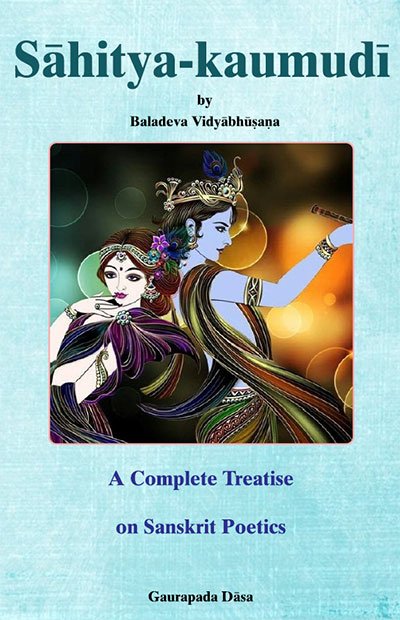Sahitya-kaumudi by Baladeva Vidyabhushana
by Gaurapada Dāsa | 2015 | 234,703 words
Baladeva Vidyabhusana’s Sahitya-kaumudi covers all aspects of poetical theory except the topic of dramaturgy. All the definitions of poetical concepts are taken from Mammata’s Kavya-prakasha, the most authoritative work on Sanskrit poetical rhetoric. Baladeva Vidyabhushana added the eleventh chapter, where he expounds additional ornaments from Visv...
Text 10.232 [Viśeṣa]
57. Viśeṣa
विना प्रसिद्धम् आधारम् आधेयस्य व्यवस्थितिः ।
एकात्मा युगपद् वृत्तिर् एकस्यानेक-गोचरा ॥ १०.१३५ ॥
अन्यत् प्रकुर्वतः कार्यम् अशक्यस्यापि वस्तुनः ।
तथैव करणं चेति विशेषस् त्रि-विधः स्मृतः ॥ १०.१३६ ॥
vinā prasiddham ādhāram ādheyasya vyavasthitiḥ |
ekātmā yugapad vṛttir ekasyāneka-gocarā || 10.135 ||
anyat prakurvataḥ kāryam aśakyasyāpi vastunaḥ |
tathaiva karaṇaṃ ceti viśeṣas tri-vidhaḥ smṛtaḥ ||10.136||
vinā—without; prasiddham—well-known; ādhāram—the container; ādheyasya—of the contents; vyavasthitiḥ—the establishment; eka-ātmā—in which the nature is the same[1]; yugapat—simultaneous; vṛttiḥ—occurrence; ekasya—of one [thing]; aneka-gocarā—whose scope is many; anyat—another; prakurvataḥ—which is accomplishing; kāryam—an effect; aśakyasya—impossible; api—although; vastunaḥ—of a thing; tathā—in that way; eva—only; karaṇam—making [an effect954]; ca—and; iti—thus; viśeṣaḥ—the ornament called viśeṣa; tri-vidhaḥ—threefold; smṛtaḥ—is remembered (is known from the tradition of poets).
Viśeṣa (extraordinary) has three varieties: (1) Representing a dependent thing without its well-known substratum, (2) One thing is in many places simultaneously in the same form, and (3) In bringing about a result, an entity effects another, unlikely result.
prasiddhādhāra-parihāreṇāpi yādheyasya viśiṣṭā sthitiḥ sa prathamo viśeṣaḥ. yā caikasyāpi vastuno yugapad aikarūpyeṇānekatra vṛttiḥ sa dvitīyaḥ. yā tu kiñcit kāryam ārabhamāṇasya kartus tenaiva vyāpāreṇāśakya-kāryāntara-nirmitiḥ sa tṛtīyaḥ. (The translation of this was incorporated in the above translation.)
Footnotes and references:
[1]:
ekātmā eka ātmā svabhāvo’rthād vṛttiḥ sthitir yasyāṃ sā tathā sā ca tathā-bhūtā anekasmin vartamānety arthaḥ (Sāra-bodhinī). ekātmety ekena svabhāvenety arthaḥ (Kāvya-pradīpa). 954 rabhasenānyat kāryaṃ kurvataḥ kartur yad aśakyasyānyasyāpi kāryasya tathaiva karaṇaṃ sa tṛtīyo viśeṣaḥ (Kāvya-pradīpa).
